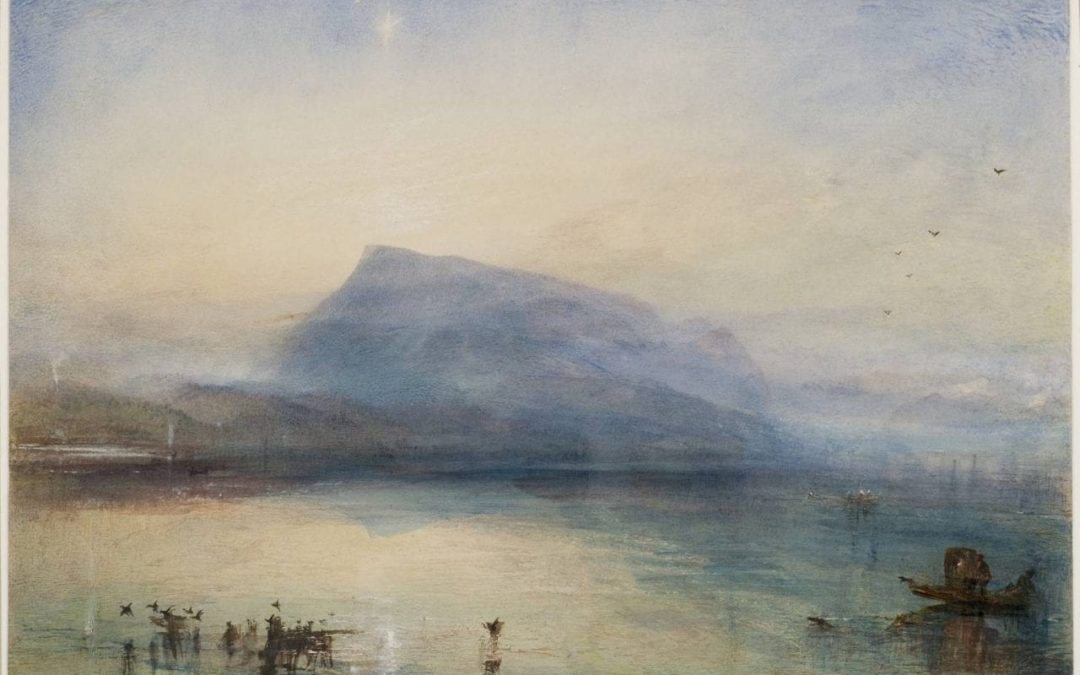Art: “The Blue Rigi, Sunrise 1842” by J. M. W. Turner
TURNER IN HIS STUDIO
Imagine his effort to be present, the years he spent training hand and eye to the qualia. How many times and with what determination did he tear himself from warm beds, grab his sketchbook and his pocket paintbox and make his way towards day? With what doggedness did he tie himself to the mast of a steamboat heading into storm, closing the distance between sea and pyche? With what devotion did he climb the steep stairs to his rooftop aerie to face the horizon again and again, lonely as a shadow for illumination?
bird on the wind
a brushstroke
feathers the light
~Published in Contemporary Haibun Online, 12:2, July 2016
http://contemporaryhaibunonline.com/index122.html
Author’s Commentary on Turner in His Studio:
The creative process interests me greatly. I’ve written a lot about the skills and strategies of artists and scientists, but to do so with any understanding, I always thought it important to experience at least some of the challenge myself. With this haibun, I do both at once. Conceiving and composing a brief piece like this can take a long time. It all began when I went to an exhibition of J.M.W. Turner’s paintings held at the J. Paul Getty Museum in Los Angeles in 2015. (Well, maybe it began when I saw my first Turner as a teenager, before I ever heard about haibun or haiku.) Anyway, as the show demonstrated, Turner produced his most inventive and enduring work in the last fifteen years of his life. That he could remain so fresh and original after the age of 60 just amazed me. I wondered how he managed it. I read about him. Not for another year, however, did it occur to me how I might write about Turner’s creative drive, not as a scholar, but as an apprentice, as a poet. One morning on waking up, the prose came to me as a series of questions and it came to me in a flash, though I did refine my thoughts somewhat over the course of the next three months. Finding and composing the right haiku moment to juxtapose to the prose proved more of a problem. I went through dozens of images, before hitting on “bird on the wind.” The trick was—is—to create a strong, yet mysterious attraction between prose and poetry, like a magnetic force that sets all the iron shavings on end, quivering.
Links:
http://www.getty.edu/art/exhibitions/turner/index.html
About the author:
Michele Root-Bernstein, late-blooming haiku poet, appears in major haiku journals as well as A New Resonance 6, Emerging Voices in English-Language Haiku; the Two Autumns Reading chapbook for 2016, Scent of the Past…Imperfect; and numerous year-end anthologies. Three of her poems are engraved on rocks along a haiku walk in Ohio. Michele recently served as associate editor of Frogpond, the journal of the Haiku Society of America. At present, she facilitates the Evergreen Haiku Study Group at the Center for Poetry, Michigan State University (MSU).
As an independent scholar, Michele also researches and writes about the creative imagination across all walks of life. She is author of Inventing Imaginary Worlds: From Childhood Play to Adult Creativity and, with Robert Root-Bernstein, co-author of Sparks of Genius, The Thirteen Thinking Tools of the World’s Most Creative People. Together they have written numerous articles and lectured widely on the wellsprings of creative culture.
Links:
https://inventingimaginaryworlds.com/
Art:
J. M. W. Turner: The Blue Rigi, Sunrise 1842. The Tate. Retrieved on 2016-03-10.

